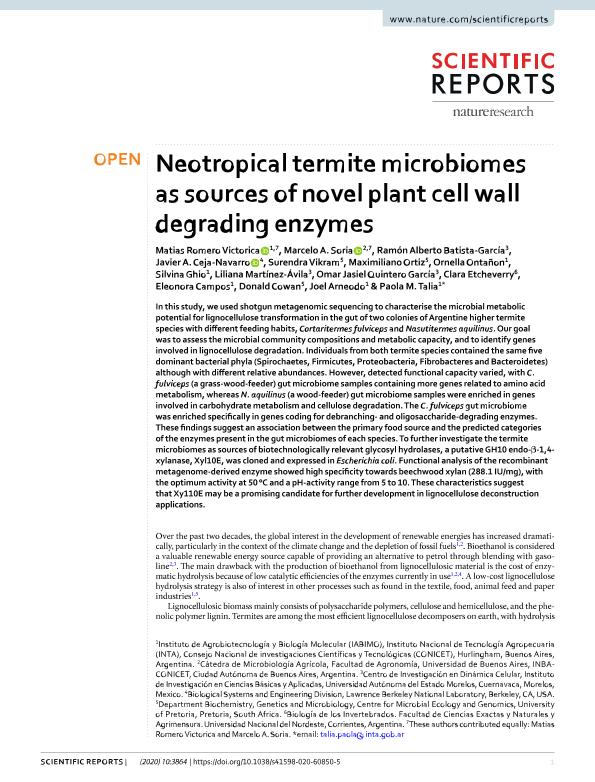Artículo
Neotropical termite microbiomes as sources of novel plant cell wall degrading enzymes
Romero Victorica, Matias ; Soria, Marcelo Abel; Batista García, Ramón Alberto; Ceja Navarro, Javier A.; Vikram, Surendra; Ortiz, Maximiliano; Ontañon, Ornella Mailén
; Soria, Marcelo Abel; Batista García, Ramón Alberto; Ceja Navarro, Javier A.; Vikram, Surendra; Ortiz, Maximiliano; Ontañon, Ornella Mailén ; Ghio, Silvina; Martínez Ávila, Liliana; Quintero García, Omar Jasiel; Etcheverry, Clara
; Ghio, Silvina; Martínez Ávila, Liliana; Quintero García, Omar Jasiel; Etcheverry, Clara ; Campos, Eleonora
; Campos, Eleonora ; Cowan, Donald Arthur; Arneodo Larochette, Joel Demián
; Cowan, Donald Arthur; Arneodo Larochette, Joel Demián ; Talia, Paola Monica
; Talia, Paola Monica
 ; Soria, Marcelo Abel; Batista García, Ramón Alberto; Ceja Navarro, Javier A.; Vikram, Surendra; Ortiz, Maximiliano; Ontañon, Ornella Mailén
; Soria, Marcelo Abel; Batista García, Ramón Alberto; Ceja Navarro, Javier A.; Vikram, Surendra; Ortiz, Maximiliano; Ontañon, Ornella Mailén ; Ghio, Silvina; Martínez Ávila, Liliana; Quintero García, Omar Jasiel; Etcheverry, Clara
; Ghio, Silvina; Martínez Ávila, Liliana; Quintero García, Omar Jasiel; Etcheverry, Clara ; Campos, Eleonora
; Campos, Eleonora ; Cowan, Donald Arthur; Arneodo Larochette, Joel Demián
; Cowan, Donald Arthur; Arneodo Larochette, Joel Demián ; Talia, Paola Monica
; Talia, Paola Monica
Fecha de publicación:
02/03/2020
Editorial:
Nature
Revista:
Scientific Reports
ISSN:
2045-2322
Idioma:
Inglés
Tipo de recurso:
Artículo publicado
Clasificación temática:
Resumen
In this study, we used shotgun metagenomic sequencing to characterise the microbial metabolic potential for lignocellulose transformation in the gut of two colonies of Argentine higher termite species with different feeding habits, Cortaritermes fulviceps and Nasutitermes aquilinus. Our goal was to assess the microbial community compositions and metabolic capacity, and to identify genes involved in lignocellulose degradation. Individuals from both termite species contained the same five dominant bacterial phyla (Spirochaetes, Firmicutes, Proteobacteria, Fibrobacteres and Bacteroidetes) although with different relative abundances. However, detected functional capacity varied, with C. fulviceps (a grass-wood-feeder) gut microbiome samples containing more genes related to amino acid metabolism, whereas N. aquilinus (a wood-feeder) gut microbiome samples were enriched in genes involved in carbohydrate metabolism and cellulose degradation. The C. fulviceps gut microbiome was enriched specifically in genes coding for debranching- and oligosaccharide-degrading enzymes. These findings suggest an association between the primary food source and the predicted categories of the enzymes present in the gut microbiomes of each species. To further investigate the termite microbiomes as sources of biotechnologically relevant glycosyl hydrolases, a putative GH10 endo-β-1,4-xylanase, Xyl10E, was cloned and expressed in Escherichia coli. Functional analysis of the recombinant metagenome-derived enzyme showed high specificity towards beechwood xylan (288.1 IU/mg), with the optimum activity at 50 °C and a pH-activity range from 5 to 10. These characteristics suggest that Xy110E may be a promising candidate for further development in lignocellulose deconstruction applications.
Archivos asociados
Licencia
Identificadores
Colecciones
Articulos (IABIMO)
Articulos de INSTITUTO DE AGROBIOTECNOLOGIA Y BIOLOGIA MOLECULAR
Articulos de INSTITUTO DE AGROBIOTECNOLOGIA Y BIOLOGIA MOLECULAR
Citación
Romero Victorica, Matias; Soria, Marcelo Abel; Batista García, Ramón Alberto; Ceja Navarro, Javier A.; Vikram, Surendra; et al.; Neotropical termite microbiomes as sources of novel plant cell wall degrading enzymes; Nature; Scientific Reports; 10; 1; 2-3-2020; 1-14
Compartir
Altmétricas



